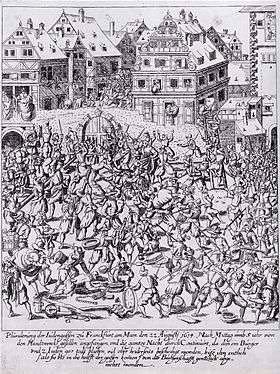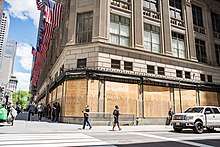Looting
Looting, also referred to as sacking, ransacking, plundering, despoiling, despoliation, pillaging, and marauding, is theft, or taking of goods by force, in the midst of a military, political, or other social crisis, such as war,[1] natural disaster (where law and civil enforcement are temporarily ineffective),[2] or rioting.[3]

The proceeds of all these activities can be described as booty, loot, plunder, spoils, or pillage.[4][5]

In armed conflict, pillage is prohibited by international law, and constitutes a war crime.[6]
Looting by type
Looting following disasters
During a disaster, police and military are sometimes unable to prevent looting when they are overwhelmed by humanitarian or combat concerns, or cannot be summoned due to damaged communications infrastructure. Especially during natural disasters, some people find themselves forced to take what is not theirs in order to survive. How to respond to this, and where the line between unnecessary "looting" and necessary "scavenging" lies, is often a dilemma for governments.[7] In other cases, looting may be tolerated or even encouraged by governments for political or other reasons. Bandits willing to take advantage of others who have looted is a likely possibility and increases the dangers associated with the act.
In armed conflict
.jpg)
Looting by a victorious army during war has been common practice throughout recorded history. Foot soldiers viewed plunder as a way to supplement an often meagre income[8] and transferred wealth became part of the celebration of victory. On higher levels, the proud exhibition of loot formed an integral part of the typical Roman triumph, and Genghis Khan was not unusual in proclaiming that the greatest happiness was "to vanquish your enemies ... to rob them of their wealth".[9]
In warfare in ancient times, the spoils of war included the defeated populations, which were often enslaved. Women and children might become absorbed into the victorious country's population.[10][11] In other pre-modern societies, objects made of precious metals were the preferred target of war looting, largely because of their easy portability. In many cases looting offered an opportunity to obtain treasures that otherwise would not have been obtainable. Since the 18th century, works of art have increasingly become a popular target. In the 1930s, and even more so during World War II, Nazi Germany engaged in large-scale and organized looting of art and property.[12][13]
Looting, combined with poor military discipline, has occasionally been an army's downfall - troops who have dispersed to ransack an area may become vulnerable to counter-attack. In other cases, for example the Wahhabi sack of Karbala in 1801 or 1802, loot has financed further victories.[14] Not all looters in wartime are conquerors; the looting of Vistula Land by the retreating Imperial Russian Army in 1915[15] was among the factors sapping the loyalty of Poles to the Russian Emperor. Local civilians can also take advantage of a breakdown of order to loot public and private property, as in events which took place at the National Museum of Iraq in the course of the Iraq War in 2003.[16] Tolstoy's novel War and Peace describes widespread looting by Moscow's citizens before Napoleon's troops entered the city in 1812, and by French troops elsewhere.
In 1990 and 1991, during the Gulf War, Saddam Hussein and troops damaged a lot of Kuwaiti and Saudi infrastructure. They also stole from private companies and homes.[17][18]
Prohibited under international law
Both customary international law and international treaties prohibit pillage in armed conflict.[6] The Lieber Code, Brussels Declaration (1874), and Oxford Manual recognized the prohibition against pillage.[6] The Hague Conventions of 1899 and 1907 ( modified in 1954) obliges military forces not only to avoid the destruction of enemy property, but to provide protection to it.[19] Article 8 of the Statute of the International Criminal Court provides that in international warfare, the "pillaging a town or place, even when taken by assault" counts as a war crime.[6] In the aftermath of World War II, a number of war criminals were prosecuted for pillage. The International Criminal Tribunal for the former Yugoslavia (operative from 1993 to 2017) brought several prosecutions for pillage.[6]
The Fourth Geneva Convention of 1949 explicitly prohibits the looting of civilian property during wartime.[6][20]
Theoretically, to prevent such looting, unclaimed property is moved to the custody of the Custodian of Enemy Property, to be handled until returned to its owners.
Archaeological removals
The term "looting" is also sometimes used to refer to antiquities being removed from countries by unauthorized people, either domestic people breaking the law seeking monetary gain, or by foreign nations, which are usually more interested in prestige or previously, "scientific discovery". An example of this might be the removal of the contents of Egyptian tombs which were transported to museums in Europe.[21] Other examples include the obelisks of Pharaoh Amenhotep II, in the (Oriental Museum, University of Durham, United Kingdom) and Pharaoh Ptolemy IX, (Philae Obelisk, in Wimborne, Dorset, United Kingdom). Whether this constitutes "looting" is a debated point, with other parties pointing out that the Europeans were usually given permission of some sort, and that many of the treasures wouldn't have been discovered at all if the Europeans hadn't funded and organized the expeditions or digs that located them. Many of these antiquities have already been returned to their country of origin voluntarily.
Looting of industry

In the aftermath of the Second World War, Soviet forces systematically plundered the Soviet occupation zone of Germany, including the Recovered Territories which were to be transferred to Poland. They sent valuable industrial equipment, infrastructure and whole factories to the Soviet Union.[22][23]
See also
- Prize of war
- Looted art
- Conflict resource
- Depredation
References
- "Baghdad protests over looting". BBC News. BBC. 2003-04-12. Retrieved 2010-10-22.
- "World: Americas Looting frenzy in quake city". BBC News. 1999-01-28. Retrieved 2010-10-22.
- "Argentine president resigns". BBC News. 2001-12-21. Retrieved 2010-10-22.
- "the definition of looting". Dictionary.com. Retrieved 2016-12-12.
- "Booty - Define Booty at Dictionary.com".
- Rule 52. Pillage is prohibited., Customary IHL Database, International Committee of the Red Cross (ICRC)/Cambridge University Press.
- "Indonesian food minister tolerates looting". BBC News. July 21, 1998. Retrieved May 11, 2010.
- Hsi-sheng Chi, Warlord politics in China, 1916–1928, Stanford University Press, 1976, ISBN 0-8047-0894-0, str. 93
- Henry Hoyle Howorth History of the Mongols from the 9th to the 19th Century: Part 1 the Mongols Proper and the Kalmyks, Cosimo Inc. 2008.
- John K. Thorton, African Background in American Colonization, in The Cambridge economic history of the United States, Stanley L. Engerman, Robert E. Gallman (ed.), Cambridge University Press, 1996, ISBN 0-521-39442-2, p. 87. "African states waged war to acquire slaves [...] raids that appear to have been more concerned with obtaining loot (including slaves) than other objectives."
- Sir John Bagot Glubb, The Empire of the Arabs, Hodder and Stoughton, 1963, p.283. "...thousand Christian captives formed part of the loot and were subsequently sold as slaves in the markets of Syria".
- (in Polish) J. R. Kudelski, Tajemnice nazistowskiej grabieży polskich zbiorów sztuki, Warszawa 2004.
- "Nazi loot claim 'compelling'". BBC News. October 2, 2002. Retrieved May 11, 2010.
- Wayne H. Bowen, The History of Saudi Arabia, Greenwood Publishing Group, 2008, p. 73. ISBN 0-313-34012-9
- (in Polish) Andrzej Garlicki, Z dziejów Drugiej Rzeczypospolitej, Wydawnictwa Szkolne i Pedagogiczne, 1986, ISBN 83-02-02245-4, p. 147
- STEVEN LEE MYERS, Iraq Museum Reopens Six Years After Looting, New York Times, February 23, 2009
- Kelly, Michael (1991-03-24). "The Rape and Rescue of Kuwaiti City". The New Republic. ISSN 0028-6583. Retrieved 2020-06-10.
- "Oil Fires in Iraq". earthobservatory.nasa.gov. 2016-09-02. Retrieved 2020-06-10.
- Barbara T. Hoffman, Art and Cultural Heritage: Law, Policy, and Practice, Cambridge University Press, 2006, p. 57. ISBN 0-521-85764-3
- E. Lauterpacht, C. J. Greenwood, Marc Weller, The Kuwait Crisis: Basic Documents, Cambridge University Press, 1991, p. 154. ISBN 0-521-46308-4
- "Egypt's Antiquities Chief Combines Passion, Clout to Protect Artifacts". National Geographic News. October 24, 2006.
- "MIĘDZY MODERNIZACJĄ A MARNOTRAWSTWEM" (in Polish). Institute of National Remembrance. Archived from the original on 2005-03-21. See also other copy online Archived 2007-04-26 at the Wayback Machine
- "ARMIA CZERWONA NA DOLNYM ŚLĄSKU" (in Polish). Institute of National Remembrance. Archived from the original on 2005-03-21.
Sources
| Wikimedia Commons has media related to Looting. |
- Stewart, James, "Corporate War Crimes: Prosecuting Pillage of Natural Resources", 2010
- Abudu, Margaret, et al., "Black Ghetto Violence: A Case Study Inquiry into the Spatial Pattern of Four Los Angeles Riot Event-Types," 44 Social Problems 483 (1997)
- Curvin, Robert and Bruce Porter, Blackout Looting (1979)
- Dynes, Russell & Enrico L. Quarantelli, "What Looting in Civil Disturbances Really Means," in Modern Criminals 177 (James F. Short, Jr. ed. 1970)
- Green, Stuart P., "Looting, Law, and Lawlessness," 81 Tulane Law Review 1129 (2007)
- Mac Ginty, "Looting in the Context of Violent Conflict: A Conceptualisation and Typology," 25 Third World Quarterly 857 (2004)